Elegant, attractive jade plants are rugged and easy to grow. In fact, they tend to thrive on neglect. They do very well in any warm, dry, bright setting, so they make an ideal home or office plant.
Because there are so many different types of Jade plants, you can amass an interesting and varied collection of these easy-care succulents.

In this article, we share some of the many different types of jade plants (Crassula), along with a few tips on Jade plant care.
Where Does The Jade Originate?
Jade plants originate in the South African deserts. They are members of the Crassula or Crassulaceae (krass-yoo-LAY-see-ee) family of plants. Crassula ovata has thick oval leaves and is generally considered the “true” jade because it is the most common.
What Is The Origin Of The Name?
Crassus is a Latin word that means fleshy or thick and refers to the thick leaves of this succulent plant.
All varieties of jade are referred to by the common term “jade” because of their deep green, jewel-toned leaves. Other common names include:
- Good Luck Plant
- Friendship Plant
- Money Plant
How Many Varieties Are There Of Jade Plants?
There are more than 1400 varieties of Crassula “jade plants,” as well as some similar plants that are often commonly referred to as jade. Here are 30 top picks.
Crassula Ovata
Crassula ovata is the most common jade tree plant. It grows large, thick, oval-shaped leaves on thick brown trunks. In ideal conditions, the plant produces star-shaped, fragrant clusters of tiny white flowers.

More on Jade Plant Care
Crassula ovata Crosby’s Red
Crassula ovata Crosby’s Red is a smallish version of the standard jade. This variety blushes when kept in full sun.
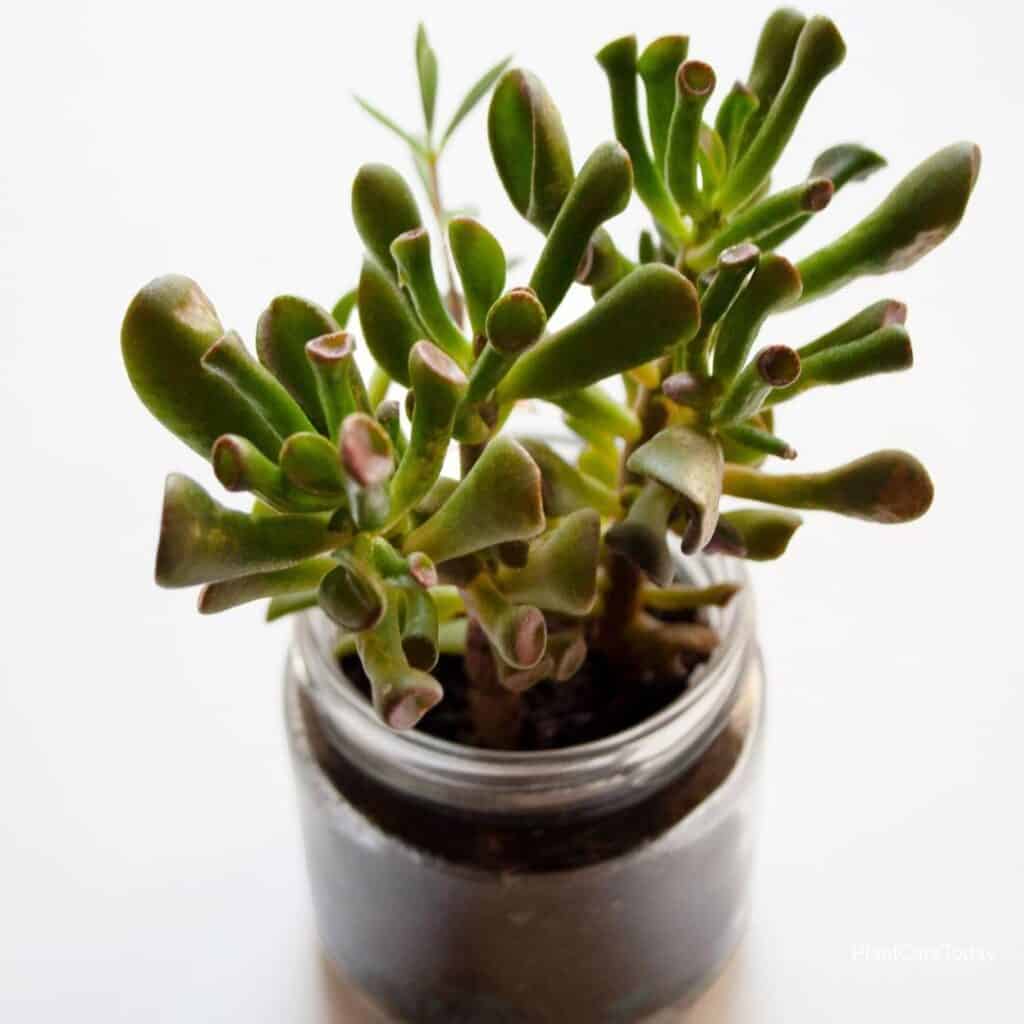
Crassula ovata Bronze Beauty
Crassula ovata Bronze Beauty is also known as Copper Jade Tree because of its attractive copper-tinted small leaves. This is a slow-growing variety.
Crassula ovata Sunset
Crassula ovata Sunset is also known as Golden Jade Tree because its leaves feature golden edging. This is a very large variety.
Monstruosa jade
Monstruosa jade has two varieties, Gollum and Hobbit. The Gollum variety has long, fingerlike leaves and grows to be about two feet high. The Hobbit variety has curly greenish/yellow leaves.

Crassula ovata convoluta Hobbit
Crassula ovata convoluta Hobbit is often called Hobbit Jade. It is a small, slow-growing variety with stumpy, tubular leaves sporting red tips. This variety attains a height of only about three feet.
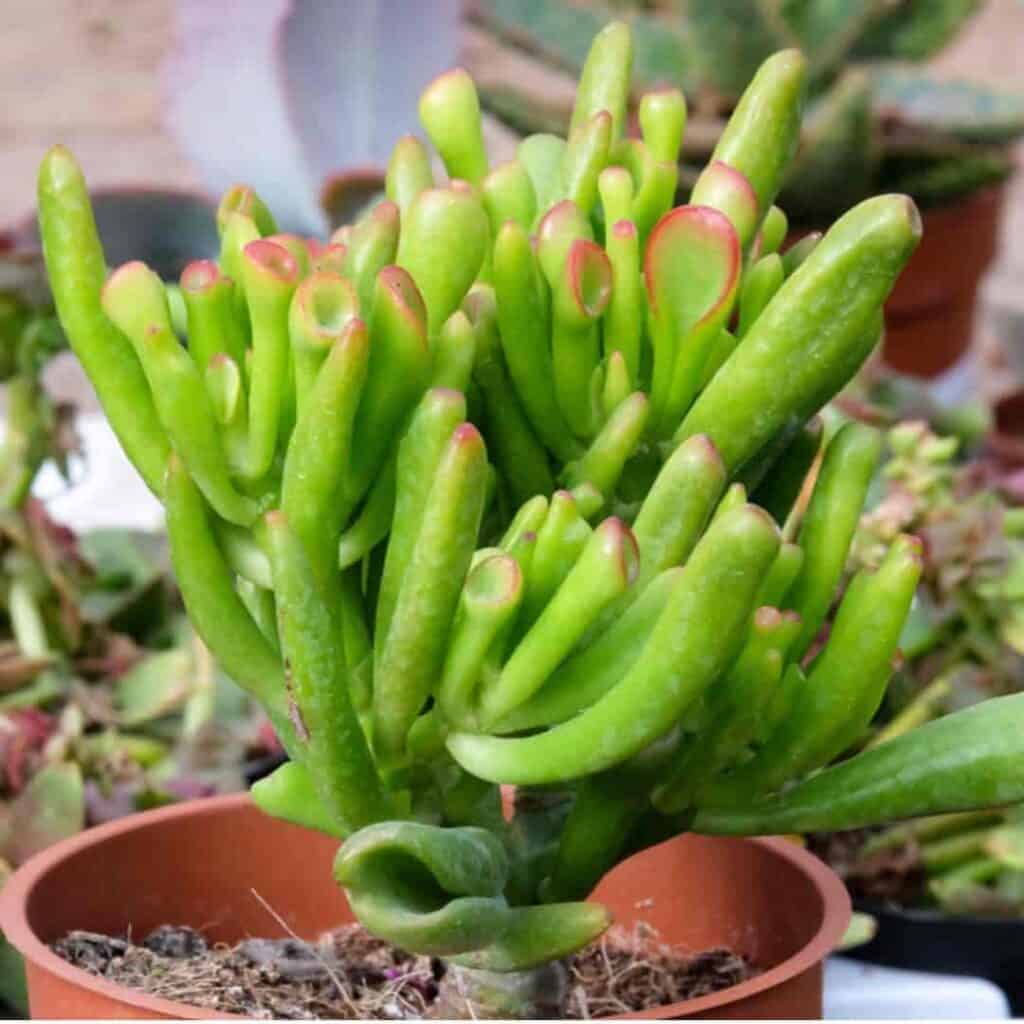
Crassula ovata Gollum variegata
Crassula ovata Gollum variegata is a variegated version of the Gollum variety. It is slightly larger and has spoon-shaped leaves of deep green flushed with orange and tipped in red.
Crassula ovata Tricolor
Crassula ovata Tricolor is an attractive plant that produces pointy leaves striped in tones of rose, green and white. This plant can grow to be four feet high under ideal conditions.

Crassula ovata California Red Tip
Crassula ovata California Red Tip is also called Red Jade Tree because, with ample bright sunlight, its leaves are edged in a deep shade of reddish-purple.
Crassula arborescens
Crassula arborescens is commonly called Bluebird or Silver Jade Plant because of its silvery or blue/grey leaves tipped with red. This plant produces clusters of small, fragrant, pink star-shaped flowers under ideal conditions. This is a low-growing variety that tends to spread wider than it is high.
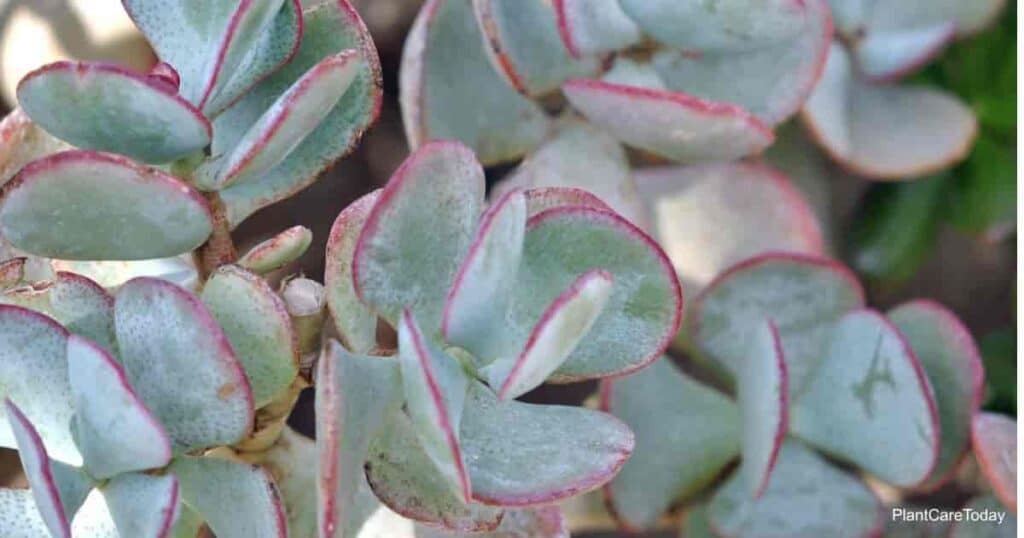
Crassula arborescens Bluebird Variegata
Crassula arborescens Bluebird Variegata has variegated leaves in shades of green, aqua, red, and cream. This is a small variety that is well suited as a houseplant or desk plant.
Crassula ovata Variegata
Crassula ovata Variegata or Variegated Jade has creamy white leaves with pale green streaks, which may develop red tips in bright sunlight.
This is a bushy variety that can attain a height of four feet. This variety likes a bit more humidity than some of the others and will bloom when humidity levels are high enough.
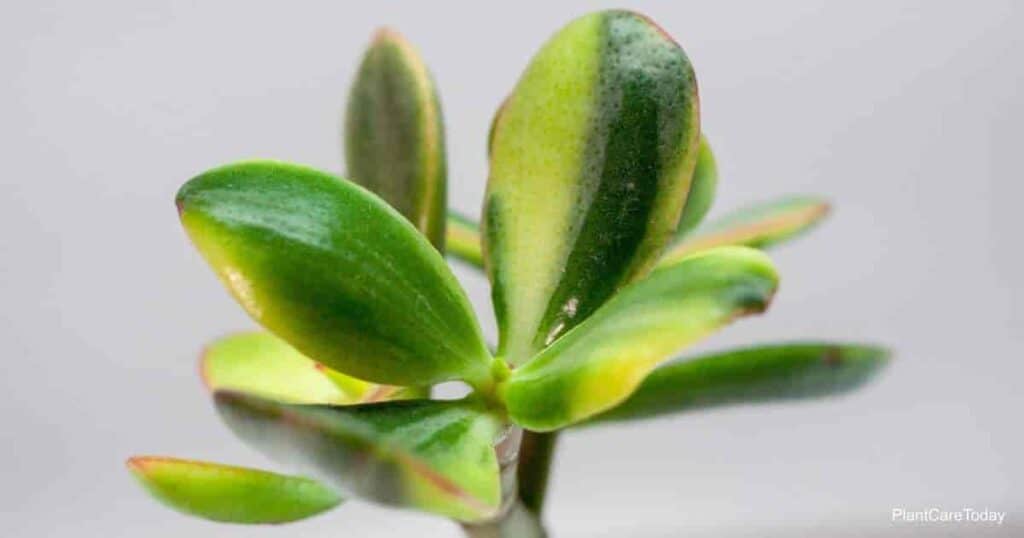
Crassula ovata Sunset
Crassula ovata Sunset or Sunset Jade has densely growing yellow leaves that have red tips. This is a lovely, compact plant that makes an excellent houseplant. It is extremely drought tolerant.
How to Make Jade Plant Leaves Turn Red
Ripple or Curly Leaf Jade
Ripple or Curly Leaf Jade is also called Blue Buddha Bush. It is a hybrid variety that likes to grow in full sun; however, it can be grown in partial shade. This variety has silvery/blue leaves with wavy red edges and can grow to be four feet high.
Crassula ovata Botany Bay
Crassula ovata Botany Bay is a relatively new cultivar that has only been around since 2011. It is compact and bushy, with pale green leaves sporting bright red tips.
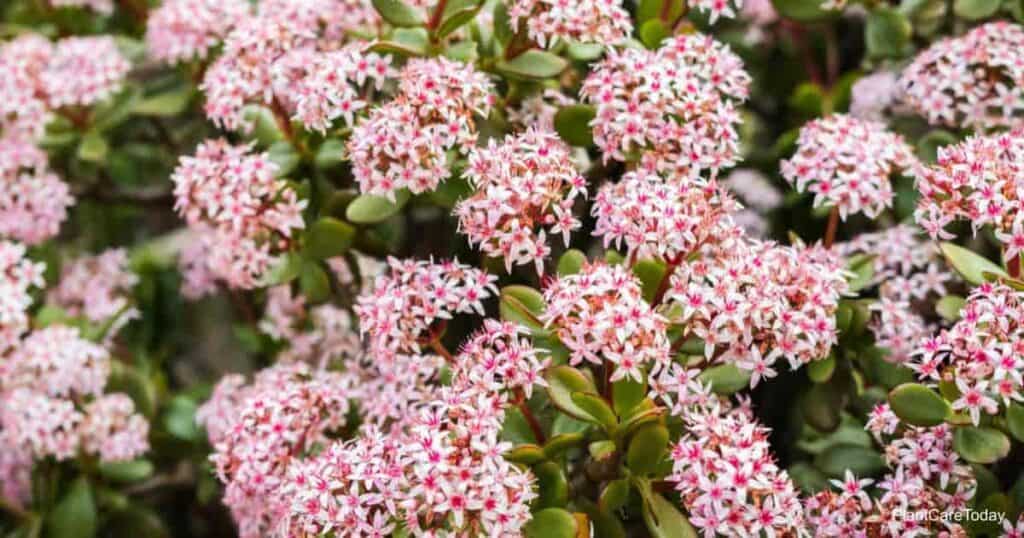
Crassula ovata Harbor Lights
Crassula ovata Harbor Lights has very thick green leaves with tinges of red. This small plant tops out at a foot high and produces pretty pale pink flowers early in the winter.
Crassula ovata Lady Fingers
Crassula ovata Lady Fingers is also called Skinny Fingers. This variety has very long, slim, fingerlike leaves.

Crassula ovata Hummel’s Sunset
Crassula ovata Hummel’s Sunset has gorgeous color-changing foliage that transitions during the wintertime. It starts out deep green, and throughout the cold winter months, changes to gold and then to red. It is a 1993 Royal Horticultural Society award winner.

Crassula ovata Little Jade Tree
Crassula ovata Little Jade Tree is very compact, topping out at sixteen inches high. Its red-edged, oval leaves are also relatively small and compact. It resembles a miniature of common jade.
Crassula ovata Minima
Crassula ovata Minima or Miniature Jade is an even smaller variety with a very distinctive growth habit. This little plant is very bushy. The leaves grow in clusters at the tips of slim branches.

Crassula ovata Pink Beauty
Crassula ovata Pink Beauty produces abundant clusters of fragrant, pink, star-shaped flowers covering the whole plant throughout the autumn and into the winter.
Crassula marginata Variegata
Crassula marginata Variegata is also known as Calico Kitten. Its heart-shaped leaves are grayish-green with edging in shades of yellow, cream, and pink.
Crassula capitella Campfire’s
Crassula capitella Campfire’s leaves grow in a propeller formation. The leaves are pale green with a flush of red. The plant blooms in summer with pretty white blossoms.
Crassula mesembryanthemoides
Crassula mesembryanthemoides is also called Moon Glow. Its grayish-green leaves are long and slim and sport a fine layer of white fur that gives it a bit of a frosty shine.
Crassula multicava
Crassula multicava is commonly called Fairy Crassula. This plant has small, spoon-shaped green leaves with red edging. Its growth habit closely resembles that of sedum plants, and it makes a good choice for a mass or group planting.

Crassula capitella Thumb
Crassula capitella Thumb is also called Red Flames because of its coloring and its growth habit. The foliage grows in a rosette formation. Grown in the sunlight, the leaves are pink. Growing in the shade, they are bright green.
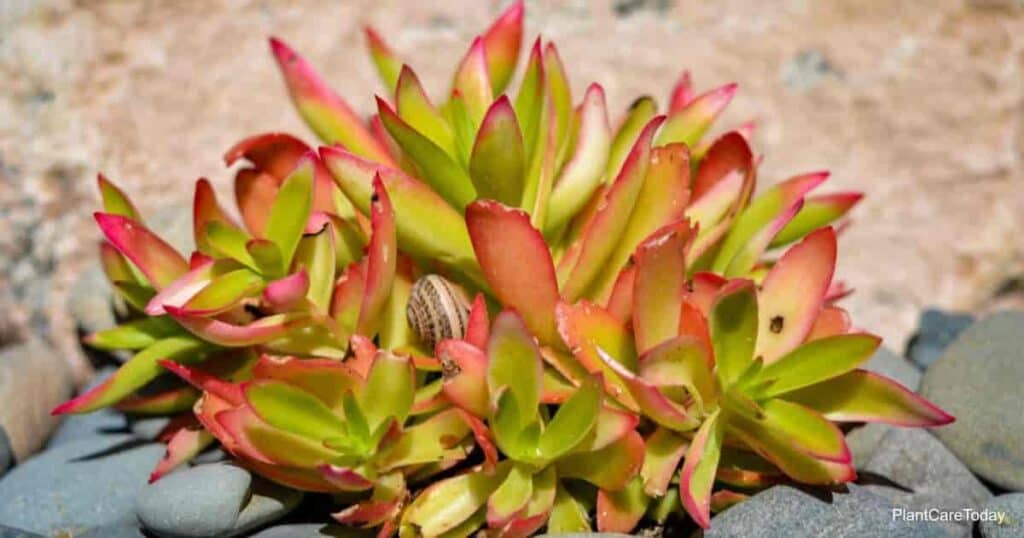
Crassula rupestris
Crassula rupestris is commonly called Baby’s Necklace plant because its gray/green leaves are round and bead-shaped, and it has a trailing growth habit.
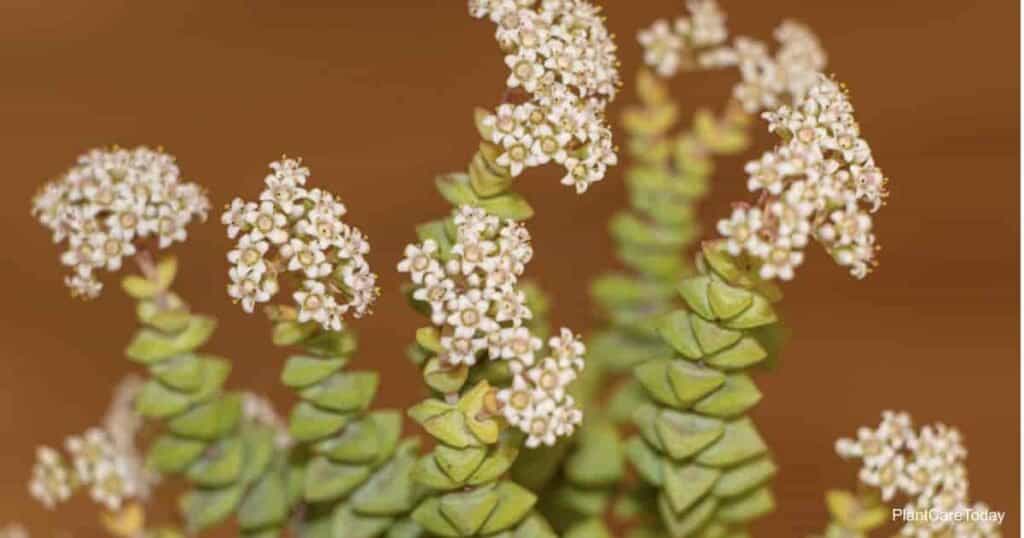
Crassula falcata
Crassula falcata is commonly known as Propeller Plant because of its growth habit. The leaves grow in a propeller formation. This plant blooms red.
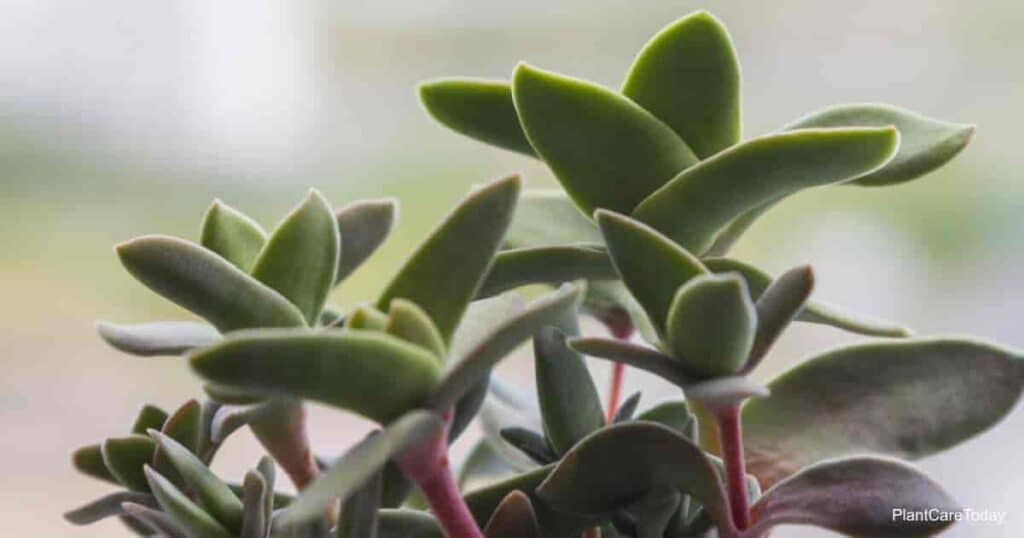
Crassula Gandalf
Crassula Gandalf is another hybrid variety that has tube-shaped leaves sporting purplish-red edging.
Crassula tetragona
Crassula tetragona is commonly called Miniature Pine Tree because its apple green leaves are needle-like, similar to the leaves of a pine tree. This plant is an excellent choice as a bonsai.

Faux Jade Plants
The Africa succulent species, Portulacaria afra, is similar to true jade plants, and its common names include:
- Dwarf Jade Plant
- Baby Jade Plant
- Elephant Bush
These plants are very small and compact. They are also extremely hardy and even easier to care for than true jade. These plants are excellent to keep as bonsai. Varieties include:
Portulacaria afra Aurea
Portulacaria afra Aurea, or Yellow Rainbow Bush, which is a sprawling, slow-growing ground cover with light green/yellow leaves and deep brown stems.
Portulacaria afra Cascade
Portulacaria afra Cascade or Trailing Elephant Bush is a cascading plant that does well in a hanging basket. It has thick, round leaves and attractive deep purplish/brown stems.
Portulacaria afra macrophylla
Portulacaria afra macrophylla or Large Leaf Elephant Bush has very large, green, fleshy leaves on deep red stems.
Portulacaria afra Variegata
Portulacaria afra Variegata or Rainbow Bush has creamy leaves marked with a green stripe in the middle and deep maroon edging.

How to Use Jade Plants in the Home, Office, and Landscape
Jade plants and the common Portulacaria imposters do very well in any consistently warm, dry, bright setting. That’s why they make excellent additions to any home or office setting.
If you are short on space, choose one of the smaller varieties and train it as a bonsai.
If you live in USDA hardiness zones 10 through 12, you can also enjoy these plants in the landscape year-round. Plant in a warm, bright setting with well-draining soil. Some protection from high winds is advised.
In cooler settings, let these cheery succulents enjoy warm weather outdoors in the spring, summer, and early autumn, but be sure to bring them in when temperatures consistently drop below 45° degrees Fahrenheit.
Related: Tips on Growing Jade Plants Outdoors
Standard indoor temperatures (65-75 degrees Fahrenheit) are ideal for all varieties of Jade plants. Avoid placing your plants too close to windows at any time of year. During the winter, contact with cold glass can cause damage. In summer, harsh, bright sunlight can cause scorching.
Kept as a container plant indoors, try to position your jade near a south-facing window to get the greatest sun exposure. These desert plants like to have plenty of bright light for optimum growth and blooming.
When grown in containers or in the landscape, jade plants like light, airy, well-draining soil with a neutral pH level. In containers, use a succulent or cactus mix. In the landscape, work in some organic matter, coarse sand, and/or pea gravel to improve aeration and drainage.
When planting in containers, choose a wide, shallow pot made of a natural, breathable material, such as terra cotta or hypertufa. Be aware that the thick leaves of jade plants can be very heavy, so you may want to add some rocks under the soil (or decoratively on the surface) to add weight and prevent toppling.
Be careful not to overwater jade. They like to be thoroughly watered and then left to become nearly dry before the next watering. Too much water will cause root rot.
Jade are not heavy feeders. Provide container plants with a light feeding of standard houseplant fertilizer early in the springtime and again mid-summer. For plants in the landscape, work in some organic compost early in the spring and/or top dress with organic mulch.

